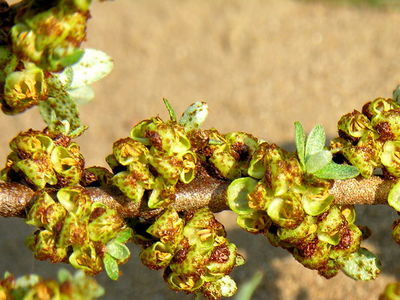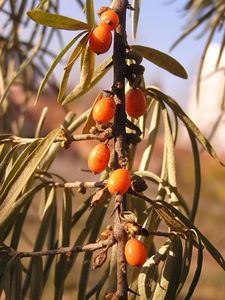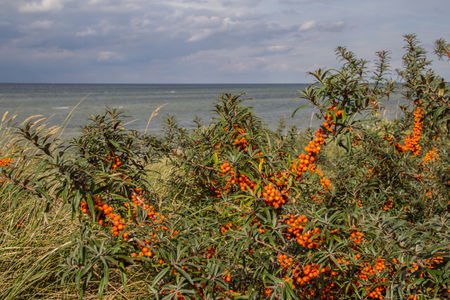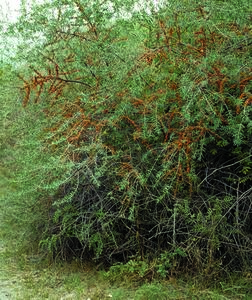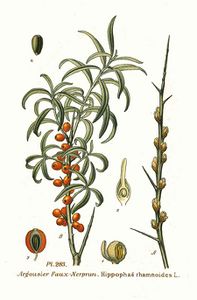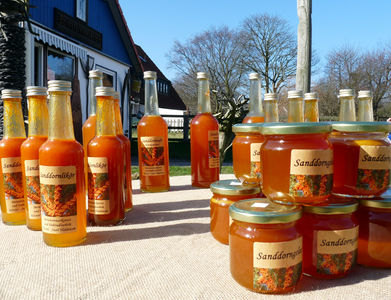Hippophae rhamnoides
Hippophae rhamnoides L.
| Ordre | Rosales |
|---|---|
| Famille | Elaeagnaceae |
| Genre | Hippophae |
2n = 12, 20, 24
Origine : Europe, Asie tempérée
sauvage et cultivé
| Français | argousier / argouse |
|---|---|
| Anglais | sea buckthorn |
- fruit comestible, surtout transformé
- huile des graines alimentaire
- médicinal
- plantée contre l'érosion, en haie défensive
ou ornementale, comme brise-vent
Sommaire
Description
- arbrisseau ou arbre de 1-15 m de haut, épineux, très ramifié, dioïque
- feuilles alternes, lancéolées, sessiles, argentées au-dessous avec des écailles rousses
- fleurs verdâtres, mâles en chatons, femelles axillaires par 1-5
- fruit globuleux-ovoïde, jaune, orange ou rouge, de 4-9 cm de long
L'espèce pousse dans deux milieux différents : les zones littorales sableuses et les montagnes (torrents).
Noms populaires
| français | argousier, griset / argouse |
| anglais | sea buckthorn |
| allemand | Sanddorn, Haffdorn, Fasanenbeere |
| néerlandais | duindoorn |
| italien | olivello spinoso, olivagno |
| espagnol | espino amarillo |
| suédois | havtorn, finnbär |
| polonais | rokitnik |
| russe | облепиха - oblepixa |
| chinois | 沙棘 - sha ji (Flora of China) |
- Voir l'étymologie de Hippophae
- Voir les noms de la Flore populaire d'Eugène Rolland
- Voir les noms néerlandais de Plantennamen in de Nederlandse Dialecten (PLAND)
Classification
- Hippophae rhamnoides L. (1753)
synonyme :
- Elaeagnus rhamnoides (L.) A.Nelson (1935), nom. inval.
Cultivars
Histoire
Usages
- Finbær, id est Baccæ Finnonum
- Baccæ sapore austero-vinoso gaudent, hinc conficiunt Piscatores sinum Bothnicum ex eis Rob, quod piscibus recentibus additum, iis gratissimum conciliat saporem.
- Finbær, c.-à-d. baie des Finnois
- Les baies ont un goût âpre-vineux, ce qui fait que les pêcheurs des golfes de Bothnie en font un sirop épais qu'ils ajoutent aux poissons frais, ce qui leur procure un goût très agréable.
One of the most adaptable and hardiest woody plants for erosion control, stabilsation of earth deposits and heap slopes, marginal and poor land reclamation, and protective hedges because of the extensive root system with many sprouts and its ability to fix nitrogen by symbiosis with actinomycetes. Sea buckthorn is rather drought resistant and salt tolerant though will not tolerate shade as well as too acid or too basic soils. It is also planted for its decorative silvery leaves and its yellow to red, acid but juicy fruits which are highly valued for its high content in vitamins C and E and for the medicinally applied essential oil from pulp and seeds. They are processed into jam, vitamin-rich beverages, and other dietary food. Wild stands have been exploited for fruits and medicinal use since ancient times. In several countries cultivars were selected for high yield and special quality of fruits. Plantations as fruit crop (Central Europe, Siberia, Mongolia) need rather fertile soil or adequate manure appliction as well as special planting (the plants are dioecious) and pruning schemes for a high yield of good-quality fruits. Harvesting of the berries can be difficult because of the spinescent twigs. Spineless cultivars as well as those suited to be harvested by cutting off the fruit-bearing twigs have been selected.
Références
- Chauvet, Michel, 2018. Encyclopédie des plantes alimentaires. Paris, Belin. 880 p. (p. 258)
- Dambourney, Louis-Alexandre, 1786. Recueil de procédés et d'expériences sur les teintures solides que nos végétaux indigènes communiquent aux laines & aux lainages. Paris, De l'imprimerie de Ph.-D. Pierres, premier imprimeur ordinaire du roi. 407 p. Voir sur Pl@ntUse
- Voir Rangelands of the arid and semi-arid zones in Uzbekistan de Gintzburger et al. (2003)

